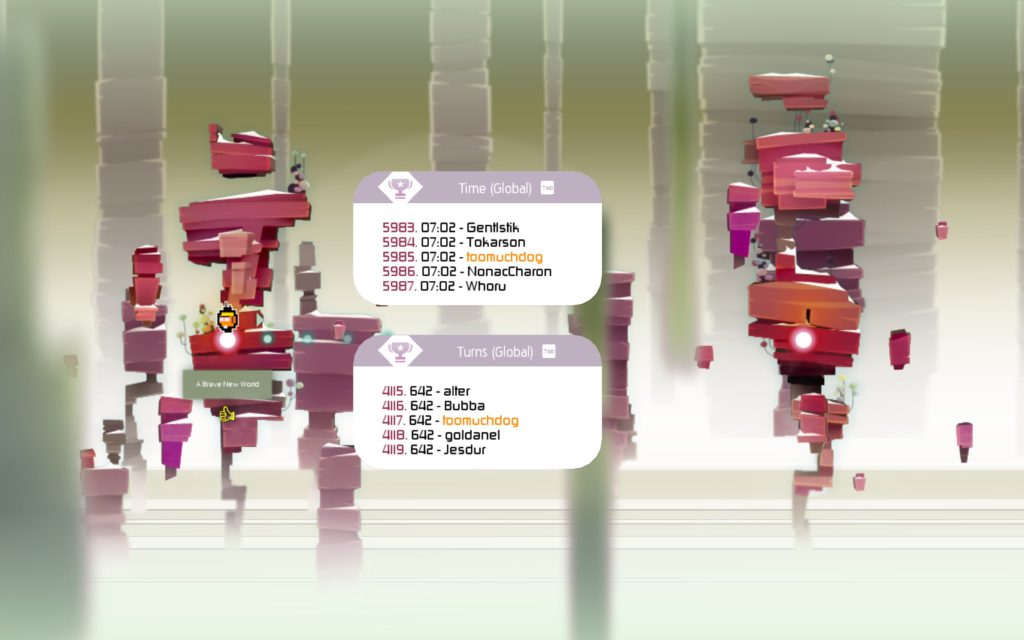Developed by: Funktronic Labs
Released: August 25, 2015
Price: $14.99 (PC, PS3, PS-Vita, PS4)
Nova-111 is a quirky little action-puzzle game developed by indie studio Funktronic Labs. Players will control a box-shaped spaceship from a side-scrolling perspective, moving up, down, left, and right on a grid in order to navigate around obstacles and defeat enemies. The game’s controls, physics, and enemies are introduced and explained through a text-based narrator named Dr. Science, a goofy British chap who speaks directly to the player via quirky quips and musings. Not staying in a single place for long, the game introduces a whirlwind of different puzzle and enemy mechanics, some of which are turn-based (movements or actions only occur each time the player moves) and some of which are real-time. For each level, leaderboards track best completion time and lowest move count; levels may require hundreds of moves (think of them more like steps taken in a grid-based space), so highscore seekers will need to be very deliberate about the moves they make. Wrapped in a pleasant art style and some impressive sound and music, Nova-111 boils down to a charming but sometimes shallow jumble of random puzzle game mechanics.
Nova-111 makes an awkward first impression, presenting some basic nonsensical backstory and then showing you the ropes via Dr. Science, our friendly British tutorializer. While he’s initially charming, he can get tedious as the game progresses, often to the point that I would ignore his little bits of monologue unless he was explaining something important. Fortunately, his talk bubbles don’t interrupt play and are fairly out of the way, should you choose to ignore them. It’s a bit of a shame, really; Dr. Science’s writing isn’t bad per se, it’s just way too much of the same. If he’d opened his mouth less, I think I would have been more likely to consistently read what he said.

As players familiarize themselves with the controls, the game will throw in a few basic enemies and puzzles to solve. Exploration is also key, as there are secret areas and collectibles tucked away for perceptive players to uncover. Unfortunately, Nova-111 starts off a little bit slow, perhaps taking a little too much time with the basic mechanics before introducing more challenge. That said, it also uses a view occlusion mechanic that blocks out spaces that aren’t in the spaceship’s line of sight, so it can be nice to take some time to get accustomed to it. Once it gets into the swing of things, however, the levels become a mounting barrage of new obstacles and enemies, often only briefly exploring some of the mechanics before moving onto others. Some interact in interesting ways (for example, enemies that do fire attacks can set certain parts of the environment on fire), but others are confusing, unintuitive, or only shallowly explored.
Despite hit-and-miss puzzle mechanics, Nova-111 frequently managed to present me with interesting puzzles or surprising and challenging combinations of enemies. Enemies that acted in real-time would require quick action, but that might lead to traps from enemies that react to the player’s movements. There were also some creative boss encounters that surprised me and forced me to try different strategies. Add to that the nifty leaderboards and there’s clearly an interesting game to explore and master amidst the chaotic jumble of different physics and obstacles. The game’s art and music are wonderful and stylish, providing an almost calming backdrop for the game’s sometimes frantic encounters.

If you don’t mind a somewhat unfocused puzzle game, there are a lot of interesting moments to get out of Nova-111. Just be warned that its puzzle gameplay doesn’t always seem quite as polished and refined as its art and sound are.
